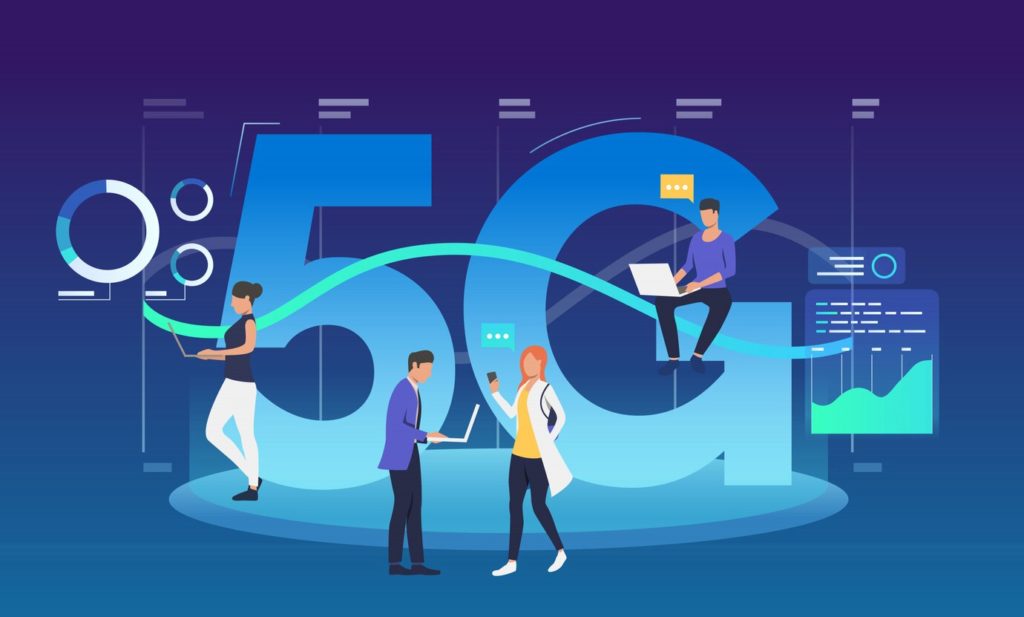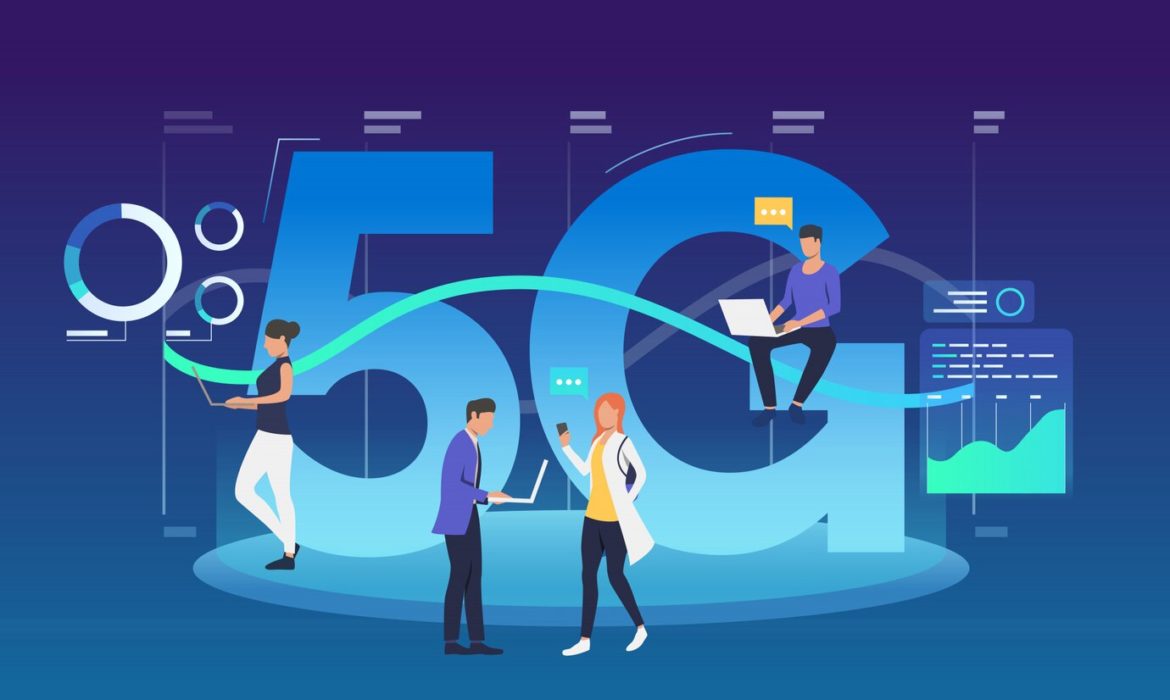
Big-size HD movies download in seconds, virtual reality is becoming commonplace, and smart cities are running on ultra-fast connectivity. This isn’t a scene from a sci-fi movie; it’s the reality that 5G technology is bringing to our doorstep.
For digital marketers and business owners, the advent of 5G isn’t just another tech upgrade—it’s a complete paradigm shift, a game-changer that demands our immediate attention and adaptation.
However, with every new technological leap comes excitement and a fair share of anxiety.
You’re probably asking yourself, “What will be the impact of 5G on digital marketing?” or “What steps do I need to take to stay ahead of the competition?” These questions are not just important—they’re critical in the rapidly evolving digital tech-scape.
In this blog, we’ll explore how the rollout of 5G technology is expected to transform digital marketing strategies and consumer behavior. By the end of this blog, you will have a clear roadmap for leveraging 5G technology and propelling your business forward.
What Is 5G?
5G, short for fifth-generation wireless technology for marketing, is the latest advancement in mobile network technology. It marks a considerable improvement over its predecessor, 4G, offering faster speeds, lower latency, and the ability to connect more devices simultaneously.
Key Features of 5G
Here are some prime benefits of 5G technology that make it more powerful than its predecessor networks:
1. Incredible Speed
5G networks can achieve data transfer rates up to 100 times faster than 4G, enabling activities like downloading HD movies in seconds and streaming high-quality videos without buffering.
2. Low Latency
With latency lessened to just a few milliseconds, 5G provides near-instantaneous data transfer, crucial for real-time applications and seamless user experiences.
3. Enhanced Connectivity
5G can support many devices per square kilometer, paving the way for the Internet of Things (IoT) and a more connected world.
4. Improved Reliability
5G offers more stable connections with fewer dropouts, even in crowded areas, ensuring consistent performance.
Why It’s High Time to Keep up With the 5G Trend
The arrival of 5G technology is not just an incremental upgrade; it’s a revolutionary leap that will reshape the digital landscape. For digital marketers, this is a pivotal moment.
Early Adaptation to 5G will provide a significant competitive advantage while falling behind could mean missing out on a wealth of new opportunities.
1. Rapid Adoption and Growth
5G is being rapidly adopted worldwide, with major cities and regions already experiencing its benefits.
As 5G networks proliferate, businesses that use this technology will be better positioned to interact with customers who want quicker and more dependable digital experiences.
2. Competitive Edge
Early adopters of 5G technology can set themselves apart from competitors by offering superior user experiences.
Faster load times, more interactive content, and seamless online interactions can significantly enhance customer satisfaction and loyalty.
Brands that integrate 5G into their marketing strategies will likely see a boost in engagement and conversions.
3. Enhanced Customer Experiences
With 5G, digital marketers can create more immersive and interactive experiences.
High-speed data transfer and low latency allow for the consumption of augmented reality (AR) and virtual reality (VR) in marketing efforts, giving customers new and interesting ways to engage with products and services.
This level of innovation can capture attention and drive deeper engagement.
4. Real-time Data and Analytics
The speed and connection of 5G enable real-time data collecting and analysis, allowing marketers to make faster and more informed decisions.
This can lead to more effective personalization, better targeting, and improved campaign performance. The ability to respond to consumer behavior in real-time can greatly enhance marketing effectiveness.
5. Future-proofing Your Business
By adopting 5G technology now, businesses can future-proof their digital marketing strategies.
As more consumers and industries move to 5G, having a solid foundation and understanding of how to leverage this technology will ensure long-term success.
Staying ahead of technological trends helps businesses remain relevant and competitive in an ever-evolving market.
Also Read: What is Conscious Marketing and Why It Matters?
Implementing 5G Technology for Digital Marketers
With the 5G era upon us, digital marketers must adapt their strategies to fully leverage this groundbreaking technology. Here’s how you can implement advanced digital marketing tactics across various services to stay ahead of the curve.
1. SEO
The speed and connectivity of 5G will transform SEO by emphasizing the importance of mobile optimization and immediate search capabilities.
Businesses must ensure their websites and content are optimized for the lightning-fast speeds and enhanced user experiences that 5G enables.
- Mobile Optimization: Make sure your website is fully optimal for mobile devices, focusing on speed and performance. Implement AMP (Accelerated Mobile Pages) and PWAs (Progressive Web Apps) to provide seamless mobile experiences.
- Voice Search Optimization: With 5G enabling more efficient voice search, optimize your content for voice queries. Use natural language and conversational keywords to capture voice search traffic.
- AI-Driven SEO: Utilize AI-powered tools to analyze search trends and user behavior in real-time. Leverage these insights to continuously refine your SEO strategy and stay ahead of the competition.
2. Social Media
5G will enhance social media interactions by enabling high-quality, live content sharing and engagement. Marketers can leverage this to create more interactive and engaging social media campaigns.
- Live Streaming: Use 5G’s low latency to deliver high-quality live streaming events. Engage your audience with Q&A sessions, product launches, and interactive webinars.
- AR and VR Experiences: Devise augmented reality (AR) and virtual reality (VR) content to provide immersive social media experiences. Use AR filters and VR environments to engage users in new and exciting ways.
- High-Quality Visuals: Create and share 4K videos and high-resolution images without worrying about load times. This enriches the visual attraction of your social media content and keeps users engaged.
3. Video Marketing
5G’s ultra-high speeds and minimal latency will transform video marketing. Marketers may create more immersive and engaging video content, resulting in enhanced engagement and conversion rates.
- 360-Degree Videos: Create 360-degree videos to offer immersive viewing experiences. This is particularly effective for virtual tours, product demonstrations, and experiential marketing.
- Personalized Video Content: Use AI to create personalized video campaigns that adapt in real-time based on viewer data. This increases relevance and engagement, driving better results.
- Interactive Video Ads: Develop interactive video advertisements that allow viewers to engage directly with the content. Use clickable elements, embedded forms, and feedback to enhance user interaction.
4. Content Marketing
With 5G, content marketing will become more dynamic and interactive. The ability to deliver rich media content quickly and reliably will enhance user engagement and satisfaction.
Marketers can leverage augmented and virtual reality to create more immersive content experiences.
- AR and VR Content: Employ augmented and virtual reality to produce immersive content experiences. This can be used for virtual product trials, interactive storytelling, and educational content.
- Interactive Infographics: Design interactive infographics that users can explore in-depth. Use 5G’s speed to ensure these load quickly and function smoothly.
- Real-Time Personalization: Leverage AI and machine learning to deliver hyper-personalized content. Use data to tailor content to individual user preferences and behaviors.
5. Paid Advertising
5G will enhance the effectiveness of paid advertising by enabling data analysis and more precise targeting. Marketers can optimize their ad spend and improve campaign performance.
- Programmatic Advertising: Use programmatic advertising platforms to leverage live bidding and ad placement. This ensures your ads are shown to the right audience at the right time.
- Dynamic Ads: Create dynamic ads that adjust in real-time based on user behavior and context. This increases relevance and engagement, leading to higher conversion rates.
- Advanced Targeting; Implement advanced targeting techniques, such as geotargeting and behavioral targeting, to reach your ideal audience. Use 5G’s data capabilities to refine your targeting strategy continuously.
5. Performance Marketing
5G’s data and analytics capabilities will greatly benefit performance marketing. Marketers can optimize campaigns more effectively and measure their impact with greater accuracy.
- On-Time Analytics: Utilize 5G’s speed to access analytics and make immediate adjustments to your campaigns. This ensures optimal performance and maximizes ROI.
- Advanced Attribution: Employ advanced attribution models to accurately measure the impact of 5G on your marketing efforts. This will help you understand which strategies are driving the best results.
- AI-Powered Optimization: Use AI-powered tools to analyze data and provide insights for campaign optimization. This qualifies as a more efficient and effective marketing strategy.
Current Challenges With 5G
While the potential of 5G technology is vast, its implementation comes with several challenges that businesses must navigate for now. In the future, it will be different.
1. Limited Availability
Despite the rapid rollout of 5G networks, coverage is still limited in many areas. This uneven distribution means that not all consumers will have access to 5G, which can influence the reach and success of your marketing campaigns.
This limited access may lead to:
- Inconsistent User Experience: Users in areas with limited 5G coverage may not experience the full benefits of your enhanced digital content, leading to inconsistencies in user experience.
- Segmented Audience: Marketing strategies may need to account for varying levels of technology adoption among your target audience, creating a need for adaptable content that performs well on both 4G and 5G networks.
2. High Initial Costs
Implementing 5G technology and upgrading existing infrastructure can be costly. Businesses must assess the expenses against the possible advantages and ensure they are prepared to make the necessary financial commitment.
Challenges associated with the cost:
- Infrastructure Upgrades: Significant investments in new hardware and software may be necessary to fully leverage 5G capabilities.
- Cost of 5G Plans: 5G plans are often more expensive than current 4G plans, increasing businesses’ operational costs.
- Device Costs: Upgrading to 5G-compatible devices can be expensive, especially for businesses that need to equip a large number of employees with new technology.
- Budget Allocation: Allocating a budget for 5G upgrades can be challenging, especially for smaller businesses. It’s crucial to prioritize investments that will deliver the most value.
3. Technical and Security Concerns
With increased speed and connectivity, 5G also brings heightened security risks. Making sure the security and privacy of data shared over 5G networks is a critical concern for businesses.
These concerns may result in the following:
- Data Security: The increased volume of data transmitted over 5G networks presents more opportunities for cyber-attacks. Businesses must invest in robust security measures to protect sensitive information.
- Privacy Issues: With more connected devices and real-time data collection, maintaining user privacy becomes more complex. Compliance with data protection regulations is essential.
4. Shorter Attention Spans
As 5G enables more rapid access to information and entertainment, consumers’ patience for slower websites and content will diminish. This can increase pressure on businesses to consistently deliver high-quality, fast-loading content.
Marketers news to take care of:
- Increased Expectations: Consumers will expect instantaneous load times and seamless interactions, requiring businesses to optimize their digital assets continuously.
- Content Delivery: Ensuring that all digital content, including images, videos, and interactive elements, loads quickly and performs well across devices is vital to maintaining user engagement.
5. Integration and Adaptation
Adapting to 5G requires not only technological upgrades but also changes in strategy and operations. Businesses need to integrate 5G capabilities into their existing systems effectively.
You have to be prepared for:
- Training and Skill Development: Employees may need training to understand and utilize new 5G technologies effectively. Investing in upskilling your team is essential.
- Operational Changes: Integrating 5G may require changes in business processes and workflows. Ensuring smooth transitions and minimal disruptions is crucial for maintaining productivity.
Opportunities 5G Will Open up for Various Sectors
The rollout of 5G technology presents a multitude of opportunities for businesses across various industries. Businesses may boost their digital marketing campaigns, improve consumer experiences, and spur innovation by utilizing 5G’s potential.
1. Retail
5G will revolutionize the retail sector by enabling more personalized and immersive shopping experiences. Faster connectivity and data processing will allow retailers to engage customers in innovative ways.
- Enhanced Mobile Shopping: With 5G, mobile shopping apps can offer faster and smoother experiences, including high-quality product videos and AR features that allow customers to visualize products in their environment.
- Personalization: Retailers can use data more quickly to personalize offers and suggestions, which boosts consumer happiness and loyalty.
- Virtual Try-Ons: AR and VR technologies can enable virtual try-ons for clothing, accessories, and makeup, providing a more engaging and interactive shopping experience.
2. Healthcare
The healthcare industry is expected to profit considerably from 5G, with improved telemedicine capabilities, in-sync health monitoring, and enhanced data management.
- Telemedicine: 5G enables high-quality video consultations and remote diagnostics, making healthcare more accessible and efficient.
- Wearable Devices: At the same time, data transmission from wearable health devices can provide continuous monitoring and instant alerts, improving patient care.
- Smart Hospitals: Enhanced connectivity allows for better integration of medical devices and systems, leading to more efficient hospital operations and patient management.
3. Entertainment
The entertainment industry will experience a surge in high-quality streaming and immersive content experiences with the advent of 5G.
- High-Quality Streaming: 5G supports ultra HD and 4K streaming with minimal buffering, providing a superior viewing experience.
- Interactive Experiences: AR and VR can create more engaging entertainment options, from virtual concerts to immersive gaming experiences.
- Higher Engagement: Faster data speeds enable live interactive events where audiences can participate, enhancing engagement and interactivity.
4. Automotive
5G will be important to the future of connected automobiles and smart transportation networks, creating new potential for innovation and efficiency.
- Connected Vehicles: 5G enables smoother communication between vehicles and infrastructure, improving traffic management and safety.
- Enhanced Navigation: Real-time data can provide more accurate and responsive navigation, helping drivers avoid traffic and find the best routes.
- Infotainment Systems: High-speed connectivity allows for advanced in-car entertainment and information systems, enhancing the driving experience.
5. Finance
The financial sector will benefit from faster, more secure transactions and enhanced mobile banking experiences driven by 5G technology.
- Mobile Banking: 5G improves the performance of mobile banking apps, offering faster and more reliable services.
- Secure Transactions: Enhanced security features of 5G can secure sensitive financial data and decrease the risk of fraud.
- Live Analytics: Financial institutions can leverage synchronized data analytics to offer personalized financial advice and products, improving customer satisfaction and engagement.
6. Marketing and Advertising
5G opens up new avenues for digital marketing and advertising, enabling more dynamic, interactive, and personalized campaigns.
- Immersive Advertisements: Use AR and VR to create immersive ads that engage users in new and exciting ways.
- Real-Time Data: Leverage synchronous data to optimize campaigns on the fly, ensuring maximum impact and efficiency.
- Advanced Targeting: Utilize the enhanced connectivity and data processing capabilities of 5G to deliver highly targeted and personalized advertising experiences.
Let’s Make Digital Marketing Work for You
We at EvenDigit are more than 80+ digital marketing experts who have successfully helped over 800+ businesses achieve their goals.
With over 15 years of experience, we have navigated through every network upgrade from 2G onwards, adapting to new tech practices at early stages.
As we enter the 5G era, our expertise and proactive approach can ensure that your business is prepared before the technology excels. Let’s collaborate to harness the power of 5G and make your digital marketing truly effective.
EvenDigit
EvenDigit is an award-winning Digital Marketing agency, a brand owned by Softude (formerly Systematix Infotech) – A CMMI Level 5 Company. Softude creates leading-edge digital transformation solutions to help domain-leading businesses and innovative startups deliver to excel.
We are a team of 70+ enthusiastic millennials who are experienced, result-driven, and hard-wired digital marketers, and that collectively makes us EvenDigit. Read More




